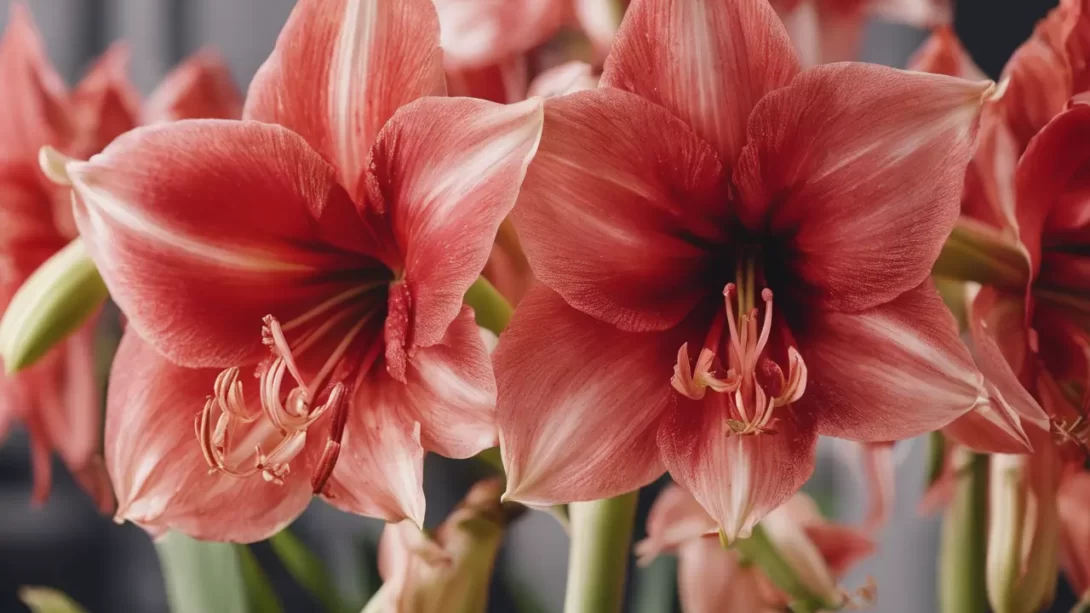Amaryllis, with its vibrant and large blossoms, has become a cherished symbol of the holiday season. Known for their dramatic and colorful flowers, Amaryllis bulbs are often cultivated to bloom around Christmas, adding a touch of elegance and cheer to holiday decor. Timing the planting of these bulbs is crucial for ensuring they peak right around the festive season. This guide will explore how to plant and care for Amaryllis bulbs to achieve a beautiful Christmas bloom.
Amaryllis
Amaryllis, scientifically known as Hippeastrum, is renowned for its spectacular trumpet-shaped flowers. These bulbs are native to tropical regions of South America but have become popular worldwide, especially during the holiday season. They are distinct from other holiday plants due to their large blooms and tall, sturdy stalks. Amaryllis flowers come in various colors, including red, white, pink, and orange, and can be single or double-bloomed.
Ideal Conditions for Growing Amaryllis
To bloom in time for Christmas, Amaryllis requires specific growing conditions. The bulbs prefer well-draining soil and a pot that provides ample space for root growth. They thrive in bright, indirect light and need a consistent temperature of about 68-70°F. Before planting, the bulbs should be stored in a cool, dark place to simulate a dormant period, which is crucial for triggering the growth and blooming process.
Timing for Christmas Blooming
Achieving a Christmas bloom with Amaryllis requires precise timing. Generally, it takes about 6 to 8 weeks for Amaryllis bulbs to bloom after planting. Therefore, to have flowers by Christmas, you should plant the bulbs in early to mid-October. Keep in mind that different varieties may have slightly varying growth rates, so it’s a good idea to check the specific blooming time for your chosen variety.
Planting Process
Planting Amaryllis bulbs correctly is essential for a successful Christmas bloom. Follow these steps:
- Choose the Right Container: Select a pot that is only slightly larger than the bulb itself, as Amaryllis bulbs prefer a snug fit. Ensure the pot has adequate drainage holes.
- Prepare the Soil: Use well-draining potting soil. You can mix in some perlite or sand to improve drainage if necessary.
- Planting the Bulb: Plant the bulb with its pointed end up. Around one-third to one-half of the bulb should be above the soil surface. Press the soil gently around the bulb.
- Initial Watering: Water the soil thoroughly after planting, then wait until the top layer of soil starts to dry out before watering again. Overwatering can lead to bulb rot.
Caring for Amaryllis During Growth
Once your Amaryllis is planted, proper care is crucial for it to bloom in time for Christmas.
- Light: Place the pot in a spot with bright, indirect sunlight. Too little light can result in leggy, weak stalks.
- Watering: Keep the soil moist but not waterlogged. Water when the top inch of soil feels dry.
- Temperature: Maintain a consistent room temperature, ideally around 68-70°F. Avoid placing the plant in drafty areas or near heat sources.
- Feeding: Use a balanced, water-soluble fertilizer every 2-3 weeks to encourage healthy growth.
Troubleshooting Common Issues
Growing Amaryllis can sometimes present challenges, but most are easily addressed:
- Lack of Bloom: If the Amaryllis does not bloom, it may be due to insufficient light or overwatering. Ensure it receives adequate sunlight and adjust your watering schedule.
- Pests and Diseases: Keep an eye out for common pests like aphids and spider mites. Treat infestations promptly with appropriate insecticides or natural remedies. Prevent fungal diseases by avoiding overwatering and ensuring good air circulation.
- Weak or Leggy Growth: This is often caused by too little light. Relocate your Amaryllis to a brighter spot, but avoid direct sunlight which can scorch the leaves.
Post-Bloom Care
After the Amaryllis has bloomed, proper care can encourage reblooming in the next season:
- After Flowering: Once the blooms fade, cut off the flower stalks near the base but leave the foliage intact.
- Continued Care: Continue to water and fertilize the plant as the leaves continue to grow. This phase is crucial for replenishing the bulb’s nutrients.
- Preparing for Dormancy: In late summer, gradually reduce watering to encourage the plant to enter dormancy. Once the leaves yellow, cut them back and store the pot in a cool, dry place for a couple of months.
- Replanting: After the dormancy period, repot the bulb if necessary, and start the cycle again for the next bloom.
Conclusion
Timing, proper planting, and care are key to enjoying the vibrant blooms of Amaryllis during the Christmas season. With the right conditions and attention, these beautiful plants can brighten your home during the holidays and can be a rewarding project for any plant enthusiast. The joy of seeing an Amaryllis in full bloom is a festive reward that is well worth the effort.



